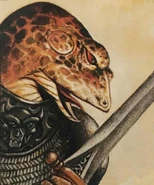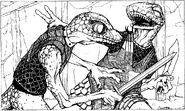Firenewts, also sometimes known as salamen,[6] were reptilian humanoids native to volcanic regions, who evolved from lizardfolk and gained the ability to breathe fire.[3]
Description[]
Firenewts were about the size of a slim human.[3] They appeared like lizardfolk with simpler faces and larger, inky-black[9] or deep crimson eyes.[3][5] Their speckled, smooth-scaled skin appeared eel-like[3][6] and was colored dark reddish brown at their spines and faded to nearly white on their front sides.[3][9] Their young were lighter in color, but darkened progressively as they matured.[5][6] They had long feet, giving them the appearance of "reversed knees", which gave them an advantage while running or leaping.[9]
Personality[]
Firenewts were known for being extreme sadists, with an extreme penchant for treachery,[10] as well as cruel marauders.[6] They delighted in torturing virtually every creature, especially sentient ones.[10][5][6]
Abilities[]
These creatures were highly resistant to harm from fire and could even breath small bouts of it out to a range of 5 feet (1.5 meters). However, they were vulnerable to extremely low temperatures and cold-based spells.[6]
Firenewts had no particular talent for arcane magic, thus they never became sorcerers or wizards.[7] Priests within firenewt society were typically capable of casting the spells animal friendship, faerie fire, predict weather, produce flame, heat metal, and pyrotechnics.[5][6] Priests of Kossuth uniquely had the spells erupt, lava missile, and lava splash.[7]
Warlocks of Imix had access to the spells burning hands, fire bolt, flaming sphere, hellish rebuke, guidance, light, mage hand, prestidigitation, and scorching ray.[8]
Combat[]
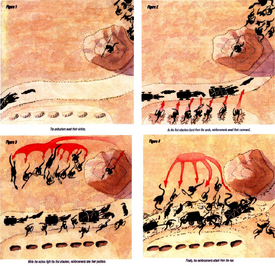
A diagram depicting the "Hammer-and-Anvil" tactic of the firenewts, being played out along a trade route in Zakhara
Firenewt warriors typically wore chain mail and carried longswords, battleaxes, scimitars,[2] longspears,[3] and pikes alongside swords, and handaxes. Battleaxes were most commonly used by their elite warriors, while their priests favored the use of maces,[5][6] and warlocks favored the use of morningstars.[8] In general, firenewts preferred to engage their enemies while on a mount.[7]
Firenewts frequently ambushed travelers,[11] though in deserts they did not set ambushes until at least an hour after sunrise due to temperature concerns.[12] They would send a smaller unit out directly ahead of their enemies,[9] who would disable the mounts of their enemies in order to both confuse and slow them down. After which a surprise attack would be mounted.[11] With the leader of that smaller unit signaling with a horn, metal shield, or polished stone, to a larger unit of mounted firenewts in a concealed position[13] just out of view. This larger unit would attack from the sides while the smaller unit peppered their foe with arrows. This was known as the “hammer-and-anvil” tactic.[9]
Despite how legendary they were for their surprise tactics, they remained very effective.[7] Firenewts often allowed captives to escape after a successful battle, simply to prolong the thrill of the hunt. In such cases their own mounts played a pivotal role in recapturing captives.[11]
History[]
The exact origin of firenewts was a mystery in the Realms. Some scholars suggested that they had evolved from lizardfolk, while others believed they were the result of magical experimentation.[9]
What's certain is that some time during the era known as the First Flowering, firenewts originated in the Firelands. Over time, raiding parties advanced into the Peaks of Flame through use of lava tubes that connected the Burning Rift with volcanoes above, then spread into the surrounding jungles.[9]
Discovering them in the early days of their empire, the yuan-ti recognized their combat prowess and moved to enlist them in their armies. By the time their empire fell and great armies disbanded, the firenewts had spread throughout the continent of Faerûn, left as isolated colonies. A few firenewts would journey back to their ancestral homeland, and a few made new homes within the continent's deserts, but most settled in other volcanic peaks throughout Faerûn.[9]
Several hundred years before the 14th century DR, three prominent mercenary bands of firenewts approached a human-led branch of the Church of Kossuth to offer their services. This branch accepted their help and used the firenewts as temple guards, as well as escorts for their traveling clergy. The arrangement would continue until eventually the firenewts were fully indoctrinated into their faith as guardians, being seen as living examples of Kossuth’s mastery over fire.[7]
During the Time of Troubles, Kossuth appeared in the Burning Rift and chose a firenewt blackguard named Chasan, the leader of a local tribe, to be his avatar. They went on to lead the firenewts in Chult into a brutal war with the pterafolk of Chultengar, a conflict that lasted all the way until the end of the Avatar Crisis. After departing the Prime Material Plane, Kossuth rewarded Chassan’s loyalty by allowing him to return to his tribe as a deathflame. Chassan would go on to lead the Ack’ta tribe by his decree well into the late-14th century DR.[7]
In 1373 DR, the Bedine began to devote enormous resources to seeking out and destroying any firenewt settlements they could find within their homeland.[10]
Society[]
For much of the 14th century DR, scholars believed that water was poisonous to firenewts and thus a commodity closely regulated by the priests in each tribe.[14] However, in the 15th century DR scholars argued that firenewts actually required a heated source of water in order to survive and breed. Separation from warm water for more than a tenday would cause one to slow mentally and physically, eventually entering hibernation. Because of this their lairs typically featured a network of channels and sluices to circulate warm water throughout.[2]
Firenewts were often known to engage in excavation and mining of their habitats, as well as fire-based alchemy.[2]
Due to their race's demeanor firenewts were often enemies or rivals of one another. Because of this tribes living in close proximity of each other were almost never on good terms. They typically either ignored each other or engaged in vicious wars.[10]
It was considered a tremendous honor for a raiding party to find the hatching chambers of a rival tribe and destroy their eggs.[5][10] Because of this, firenewts kept their hatching grounds secret and closely guarded.[6][7] Typically by a priest, a single elite warrior, and two giant striders[15] or one to three fire lizards.[5][6]
Within these hatching grounds an egg would be placed close to some source of heat, such as lava vents.[7] The eggs of their mounts were typically hatched in this same location.[11][15] Eggs typically hatched after a period of six months. Hatchlings would be separated by their sex and assigned to groups of ten that were each raised and taught by two females.[5]
Diet[]
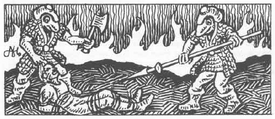
Two firenewts torture a human captive
Firenewts were a carnivorous species.[5] They preferred to dine upon humanoids of almost any kind. Their preferences in order were humans, elves, dwarves, and then all other types of humanoids. They could survive on the meat of herd animals, wild beasts, or even rodents — but they only resorted to such fare when their preferred food was completely unavailable.[10] Though they appreciated the large amounts of meat that mounts such as horses, camels, and elephants could provide.[12] In some cases they would even resort to cannibalism of their firenewt enemies.[5]
They delighted in roasting their victims alive before eating them.[6] In fact, their traditions held that brutally torturing a creature before its death made it tastier, though such tortures were never as brutal as their society's death penalty.[10] The juiciest part of any meat was first served to their society's priests, then the rest were distributed among the members of a tribe.[10][14] The offal from these victims was fed to their animals.[14]
Homelands[]
Most firenewts lived in mountainous peaks,[10] deserts,[7] regions with hot springs, regions with volcanic activity, or regions with similar hot and wet conditions.[2]
In south Faerûn these creatures could be found in the Lake of Steam region and that sea's island Arnrock. In northwest Faerûn they could be found in Mount Hotenow. In interior Faerûn they could be found in the mountains of Turmish. And in Anauroch they could be found on the Hill of Lost Souls.[16]
Beyond the continent of Faerûn firenewts inhabited the Raurin desert of the Hordelands,[17] as well as in the Peaks of Flame[16] and Valley of Lost Honor in Chult.[18]
Beyond Toril, firenewts could be found living on the sun of Realmspace.[19] Beyond the Prime Material plane, they could be found in the Elemental Plane of Fire.[20] There many inhabited the Rookery district of the City of Brass.[21]
Societal Roles[]
The societal nature of firenewt tribes was best described as being militaristic theocracies.[2]
- Priests
- Clerics were an important element within firenewt society.[7] They oversaw many of the day-to-day functions within tribes. They decided which of their captives became meals, offered healing as needed, and attended to their tribe's welfare. Such as handling most criminal proceedings,[10] training their mounts and making them into very capable combatants in their own right,[6] torturing and preparing food,[7] monitoring the activities of their hatching grounds,[6] and ensuring eggs were properly hatched.[7] On occasion they would engineer failed hatchings in order to end the bloodlines of their enemies (For more on that, see the "Religion" section).[7][15]
- Overlord
- Typically the most charismatic individual in a tribe, these made the major decisions in tribes. Only they had the authority to declare war, but in many cases they simply chose other actions that required fewer resources, such as harassing enemies with quick raids. They could also judge criminal proceedings if desired.[10] They evenly distributed gold from raids among members of a tribe, though clerics normally received the largest portion.[7][15]
- Warlock
- In firenewt societies where Imix was worshiped instead of Kossuth, a warlock took the role of a cleric. They often sent warriors out on raids for captives and treasures. They would take the choicest of loot for themselves as a tithe, then have the rest divided among the warriors according to their merit.[2]
Justice[]
Societal laws varied among firenewt tribes, though murder and food theft were the most commonly addressed concerns.[10]
Due to their race's demeanor, murder wasn't uncommon within many tribes. Often times when a firenewt was murdered the standard assumption was that the individual had just wandered away and failed to return. Otherwise, they would just let their rivals die in the heat of battle from their enemies. Only the fear of retribution from one's leader, priests, or the family of the slain kept it from being a common occurrence.[10]
The common penalty for those found guilty of murder was death. The condemned would first be tortured for a minimum of three days. Then various body parts would be removed, stabbed, or sliced open. Finally, the firenewt would be treated with the herb sarsson and fed alive to their own mount.[10]
Religions[]
Firenewts were primarily known to worship Kossuth. Their priests taught that he freed their race from the dominion of the World Serpent and imbued them with flame.[7] However, some tribes instead worshiped Imix. Those who worshiped Imix were typically motivated to be aggressive, cruel, and wrathful. The warlocks of these tribes taught that by demonstrating such qualities, a warrior could become "touched" by the Fire Lord during combat and sent into a nearly unstoppable rage.[2]
Firenewts followed most of the same teachings as Kossuth worshipers elsewhere in Faerûn — the belief that their souls were tempered by fire, that fire was the cleansing force of the multiverse, that only the strongest survived fire, and that they needed to test themselves with pain.[7]
However, firenewts could not test themselves with fire like other Kossuth worshipers. Thus they often sought to test their young's worthiness by submerging them in cold water for as close to a full minute as possible. Those who endured an entire minute without crying out were deemed worthy of priesthood, those who endured less than half were sacrificed to Kossuth, and the rest became warriors.[7]
However, unlike other Kossuth worshipers the firenewts only had one religious body entrusted with leading them in faith, the Chalices of Brass. They also believed that Kossuth was a firenewt made of living flame and each tribe had a golden idol in his image that varied in size. Once a large enough supply of gold was acquired from raids, clerics would melt their idol down and reforge it into a larger one.[7][15] It was believed that the larger an idol, the greater the blessings that Kossuth would bestow upon a tribe. Small tribes often had idols worth at least 500 gold pieces, while larger ones had idols worth up to 5,000 gold pieces.[15]
Whenever a newborn could not tear free of their egg within a minute it was viewed as a sign that Kossuth was displeased with them. In such a case, a tribe's clerics would sacrifice the hapless newborn to their god. Though such a circumstance was rare.[7][15]
Beyond their own communities, more than a hundred firenewts could typically be found within temples to Kossuth acting as guardians.[7]
Languages[]
Firenewts typically knew how to speak Draconic[2][3] and Ignan.[2] Occasionally the overlords, priests, and elite warriors within firenewt tribes knew how to speak Common. However, they deliberately chose not to.[14]
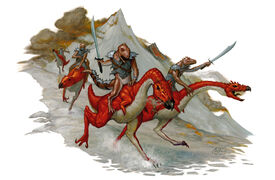
Firenewts riding into battle on giant striders.
Relationships[]
Besides other firenewts, these creatures typically concentrated their raids against other humanoids. Such as goblins, orcs, and other mountain-dwellers. In Anauroch, firenewts were a constant source of harassment for Bedine tribes.[10] Firenewts viewed most other creatures as little more than food[11] and thus were not often found living among them. Though if a tribe was ever slaughtered, the survivors would often join nearby mercenary groups.[7]
They kept some creatures as slaves if they were deemed fit for mining or other chores around a lair, they were kept as slaves. If they were not deemed fit for performing such things were ritually sacrificed.[2]
Giant striders were the only form of domesticated mount within firenewt society.[3][9] They provided shelter and food for giant striders, as well as breeding grounds in their lairs.[2] When a giant strider outlived its usefulness, which typically occurred after fifteen years of age, they were killed and eaten.[13][22] Their hides were used for leathermaking and their bones were made into tools,[11] for such things as saddles and signal horns respectively, while their tendons and ligaments were used to make saddle bindings.[13]
Besides giant striders, firenewts domesticated fire lizards and used them to guard the hatching grounds of their lairs.[5][6]
They sometimes acted as servants of, or were enslaved by, efreeti.[21]
Usages[]
The blood of a firenewt could be mixed with the blood of a red dragon in a broth to enchant its tooth.[23]
Rumors & Legends[]
One rumor claimed that several firenewts in the Peaks of Flame turned their backs on their tribes and were then taken in by a couatl.[7]
How firenewts came to acquire their race's primary form of mounts, the giant striders, was a matter of some speculation.[10] Some among them believed they were a gift bestowed upon them by Imix because they were able to breath fire.[2]
According to another legend, the red dragon Imvaernarhro was in search of fire-based creatures to serve him when he came upon the firenewt colony of the Peaks of Flame. In return for a large band of them, he offered the firenewts an immense pile of gold with which they could use to recast their statue of the deity Kossuth. But having looked upon knights and recognized how valuable mounts were to them in combat, the firenewts countered — in return for some beast they could ride and breed, they would give him fifty of their warriors. Imvaernarhro agreed to their terms and returned six months later with an immense bag, filled with giant strider eggs, and after quickly discovering their usefulness the firenewts honored their agreement.[10]
Appendix[]
Gallery[]
Appearances[]
Adventures
Video Games
Board Games
Organized Play & Licensed Adventures
Further Reading[]
- Paul Culotta (March 1999). “The Ecology of Hammer & Anvil: Firenewt and Giant strider”. In Dave Gross ed. Dragon #257 (TSR, Inc.), pp. 88–94.
Connections[]
References[]
- ↑ Jeff Grubb and Tim Beach (September 1991). Fires of Zatal. (TSR, Inc), p. 56. ISBN 1-5607-6139-3.
- ↑ 2.00 2.01 2.02 2.03 2.04 2.05 2.06 2.07 2.08 2.09 2.10 2.11 2.12 2.13 2.14 2.15 Mike Mearls, et al. (November 2016). Volo's Guide to Monsters. Edited by Jeremy Crawford, et al. (Wizards of the Coast), p. 142. ISBN 978-0786966011.
- ↑ 3.00 3.01 3.02 3.03 3.04 3.05 3.06 3.07 3.08 3.09 3.10 James Wyatt, Rob Heinsoo (February 2001). Monster Compendium: Monsters of Faerûn. Edited by Duane Maxwell. (Wizards of the Coast), p. 48. ISBN 0-7869-1832-2.
- ↑ Richard Baker and James Wyatt (2004-03-13). Monster Update (Zipped PDF). Web Enhancement for Player's Guide to Faerûn. Wizards of the Coast. p. 4. Archived from the original on 2016-11-01. Retrieved on 2018-09-10.
- ↑ 5.00 5.01 5.02 5.03 5.04 5.05 5.06 5.07 5.08 5.09 5.10 5.11 5.12 David Cook, Steve Winter, and Jon Pickens (1989). Monstrous Compendium Volume Three Forgotten Realms Appendix (MC3). (TSR, Inc), p. 46. ISBN 0-88038-769-6.
- ↑ 6.00 6.01 6.02 6.03 6.04 6.05 6.06 6.07 6.08 6.09 6.10 6.11 6.12 6.13 6.14 Don Turnbull (1981). Fiend Folio. (TSR Hobbies), p. 37. ISBN 0-9356-9621-0.
- ↑ 7.00 7.01 7.02 7.03 7.04 7.05 7.06 7.07 7.08 7.09 7.10 7.11 7.12 7.13 7.14 7.15 7.16 7.17 7.18 7.19 7.20 7.21 7.22 Ed Greenwood, Eric L. Boyd, Darrin Drader (July 2004). Serpent Kingdoms. (Wizards of the Coast), p. 37. ISBN 0-7869-3277-5.
- ↑ 8.0 8.1 8.2 Mike Mearls, et al. (November 2016). Volo's Guide to Monsters. Edited by Jeremy Crawford, et al. (Wizards of the Coast), p. 143. ISBN 978-0786966011.
- ↑ 9.0 9.1 9.2 9.3 9.4 9.5 9.6 9.7 9.8 Ed Greenwood, Eric L. Boyd, Darrin Drader (July 2004). Serpent Kingdoms. (Wizards of the Coast), p. 35. ISBN 0-7869-3277-5.
- ↑ 10.00 10.01 10.02 10.03 10.04 10.05 10.06 10.07 10.08 10.09 10.10 10.11 10.12 10.13 10.14 10.15 10.16 Ed Greenwood, Eric L. Boyd, Darrin Drader (July 2004). Serpent Kingdoms. (Wizards of the Coast), p. 36. ISBN 0-7869-3277-5.
- ↑ 11.0 11.1 11.2 11.3 11.4 11.5 Ed Greenwood, Eric L. Boyd, Darrin Drader (July 2004). Serpent Kingdoms. (Wizards of the Coast), p. 38. ISBN 0-7869-3277-5.
- ↑ 12.0 12.1 Paul Culotta (March 1999). “The Ecology of Hammer & Anvil: Firenewt and Giant strider”. In Dave Gross ed. Dragon #257 (TSR, Inc.), p. 89.
- ↑ 13.0 13.1 13.2 Paul Culotta (March 1999). “The Ecology of Hammer & Anvil: Firenewt and Giant strider”. In Dave Gross ed. Dragon #257 (TSR, Inc.), p. 90.
- ↑ 14.0 14.1 14.2 14.3 Paul Culotta (March 1999). “The Ecology of Hammer & Anvil: Firenewt and Giant strider”. In Dave Gross ed. Dragon #257 (TSR, Inc.), p. 92.
- ↑ 15.0 15.1 15.2 15.3 15.4 15.5 15.6 Paul Culotta (March 1999). “The Ecology of Hammer & Anvil: Firenewt and Giant strider”. In Dave Gross ed. Dragon #257 (TSR, Inc.), p. 93.
- ↑ 16.0 16.1 James Wyatt, Rob Heinsoo (February 2001). Monster Compendium: Monsters of Faerûn. Edited by Duane Maxwell. (Wizards of the Coast), p. 49. ISBN 0-7869-1832-2.
- ↑ David Cook (August 1990). “Volume II”. In Steve Winter ed. The Horde (TSR, Inc.), p. 125. ISBN 0-88038-868-4.
- ↑ Christopher Perkins, Will Doyle, Steve Winter (September 19, 2017). Tomb of Annihilation. Edited by Michele Carter, Scott Fitzgerald Gray. (Wizards of the Coast), p. 83. ISBN 978-0-7869-6610-3.
- ↑ Dale "slade" Henson (April 1991). Realmspace. Edited by Gary L. Thomas, Karen S. Boomgarden. (TSR, Inc), p. 5. ISBN 1-56076-052-4.
- ↑ Monte Cook and William W. Connors (December 7, 1998). The Inner Planes. Edited by Michele Carter and Ray Vallese. (TSR, Inc.), p. 45. ISBN 0-7869-0736-3.
- ↑ 21.0 21.1 Wolfgang Baur (November 1993). Secrets of the Lamp. Genie Lore. (TSR, Inc.), pp. 23–24. ISBN 978-1560766476.
- ↑ David Cook, Steve Winter, and Jon Pickens (1989). Monstrous Compendium Volume Three Forgotten Realms Appendix (MC3). (TSR, Inc), p. 54. ISBN 0-88038-769-6.
- ↑ Dale Donovan (January 1998). Cult of the Dragon. Edited by Julia Martin. (TSR, Inc.), p. 82. ISBN 0-7869-0709-6.


